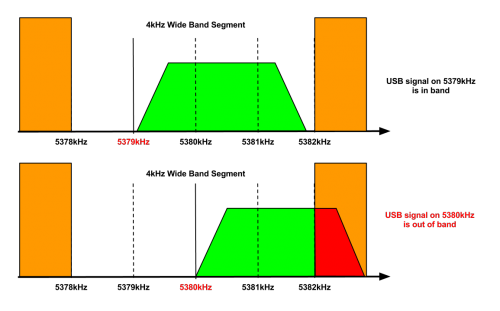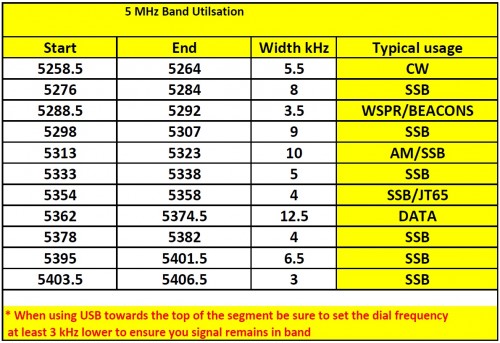If you’re a UK based advanced (full) license holder then you already have access to 5 MHz without the need for any special NOV’s. Most modern radios will already transmit on 5 MHz, others will need modification or wideband for TX. If you have tested your radio on 5MHz and it wont transmit then you could take a look at mods.dk
So lets assume your radio is ready to go..
5 MHz is not like other amateur bands, we don’t have one continuous allocation, more segments of activity.Like the primary user its best to stick to USB on 5 MHz, although technically no reason why you couldn’t use LSB ! The band has pockets of activity, some frequencies are used for CW, Data and Phone. All of the frequencies I quote will be USB dial freq, and these could form the basis for you to program into memory channels. While the new allocation can be portrayed as “band segments” it’s often easier to think of discreet channel numbers.
If you hear another amateur calling CQ be sure to check the band allocation as not all channels have been harmonised. This can even apply to returning a CQ call from another UK amateur, check before you transmit !
You can download a PDF of this guide to keep by your radio here.
A PDF visualising the band plan is available to download on G3NRW site. The RSGB have also provided a guide online.
The RSGB provide a handy guide to ensure all of your signals remains in the band.

Power is limited to 100w from your radio, and amateurs are secondary users (MOD is primary) I would suggest additional care is taken to ensure you always operate in-band and identify your station call sign at regular intervals. Operating away from your main station address is permitted either /P or /A but no mobile usage is permitted.
The band is ideal for short-range NVIS contacts during the day, typically 50 to 400 miles, and after dark, the band does support some further DX. In the winter the band often closes shortly after dark, but in the summer it will support short hop NVIS all night.
The band does support various digital modes CW, JT65, JT9 and WSPR. The centre of activity for each mode (USB Dial Freq)
CW – 5260 and 5262
WSPR 5287.2
Olivia 5366.5
FT8 5357*
*Remember when operating FT8 the dial frequency is 5357 USB, and you must not TX above 1000 Hz on the waterfall. You will see EU stations calling above 1000Hz, simply lock your TX to below 1K and work them as normal. The RSGB offers some further advice.
73 Dave M0TAZ


“although technically no reason why your couldn’t use LSB”
1) your should be you
2) there is a very good reason why you can’t use LSB. Because the licence says USB only, essentially making LSB use in contravention to your licence, and thus illegal. Apart from that, there’s no reason 😉
You will have to tell me where that is in the license schedule ?
(g) Where Radio Equipment is being used in the 5 MHz band, the following
specific terms and conditions will also apply:
(i) When operating double sideband, the maximum bandwidth shall not
exceed 6kHz;
(ii) Notwithstanding the maximum peak envelope power expressed in the
table, above, the maximum radiated power must not exceed 200
Watts eirp;
(iii) The antenna height shall not exceed 20 metres above ground level;
(iv) The Licensee must not cause interference to the use made of the 5
MHz band by the Ministry of Defence (“MoD”) and must close down
any apparatus that operates in the 5 MHz band if he or she becomes
aware that such use is causing undue interference to the MoD’s use of
the band;
(v) Communication may be established with military or military cadet
organisations by transmitting and receiving only in the 5 MHz band;
(vi) Particular care must be taken to ensure radiation does not take place
outside the specified frequencies within the 5 MHz band;
(vii) Where the Licensee intends to operate within a “net” (a network), the
Licensee shall observe the following requirements in relation to the
transmission of his or her Callsign:
(a) The Licensee shall transmit the station Callsign when he
first joins the net and on leaving it;
(b) subject to sub-clause (c) below, whilst participating in the
net, the Licensee shall not be required to transmit the
station Callsign when making contact with other
participants;
Page 22 of 23
(c) where the Licensee’s transmissions have been other than
in speech mode for at least fifteen minutes, the Licensee
shall transmit his call sign when next he transmits speech.
(viii) The Licensee shall operate the Station only at the Main Station
Address or at a Temporary Location within the United Kingdom.
(ix) At a Temporary Location within the UK, the Licensee shall give the
location of the Station every 30 minutes to an accuracy of at least 5km
by a generally used identifier as indicated in Note (e) to the “Notes to
the licence”;
(x) The Licensee shall only operate the Station to the extent that the
Licensee can be contacted on a telephone which is located in close
proximity to the Station.
(xi) In this footnote, “the 5 MHz band” means the radio spectrum between
5.2585 MHz and 5.4065 MHz
is there a ft8 / ft4 segment i assume this is in the jt65 segment 5.357
Yes indeed 5357, but be sure not to TX beyond the 1000hz in the waterfall. The band edge is 5358.lock your tx to below 1k and you can then reply to anyone calling. Dave